Mangrove Forests: Vital for Coastlines and Marine Life
Mangrove forests play a crucial role in protecting coastlines and supporting marine life. Their extensive root systems absorb wave energy, reducing erosion by 5-35% during storms, which helps to stabilize shorelines.
For example, during Hurricane Katrina in 2005, mangrove forests in Louisiana reduced wave energy by 15%, minimizing damage to coastal communities.
Mangroves serve as vital nursery grounds for juvenile species, with 75% of commercially caught fish relying on mangroves at some point in their life cycle.
For instance, species like shrimp, crab, and lobster use mangrove roots as hiding places from predators, allowing them to grow and thrive.
Mangrove ecosystems enhance biodiversity, hosting over 1,500 species. These ecosystems facilitate nutrient cycling, which boosts marine productivity.
For example, mangrove leaves and branches fall into the water, providing food for fish and other marine animals.
Unfortunately, mangroves face significant threats from development and climate change.
Understanding these dynamics is essential for effective conservation strategies and realizing their ecological value in coastal management.
Ecological Importance of Mangroves
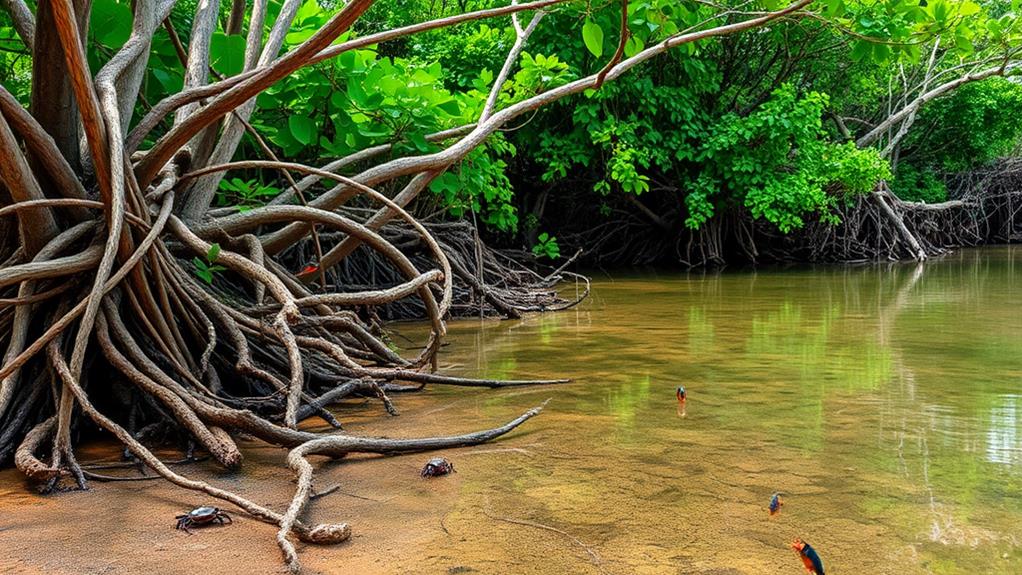
Mangrove Forests: Crucial for Ecological Balance
Mangrove forests support a vast array of species and play a vital role in maintaining ecological balance. Over 1,500 species, including many threatened ones, rely on mangroves for shelter. In fact, nearly half of mammal species found in mangroves are at risk of extinction.
Nutrient Cycling and Marine Biodiversity
Decaying leaves in mangrove ecosystems facilitate nutrient cycling, creating productive food webs that boost marine biodiversity. This process is essential for supporting the complex network of marine life.
Coastline Stabilization
The extensive root systems of mangroves stabilize coastlines by absorbing wave energy and acting as natural barriers against storm surges and tsunamis. This protective function is essential for safeguarding coastal communities and infrastructure.
Carbon Sequestration
Mangroves have an unparalleled ability to capture carbon, storing up to five times more carbon than terrestrial forests. This remarkable capacity for carbon sequestration significantly contributes to climate change mitigation efforts.
Restoration and Conservation
Restoring mangrove forests is crucial for sustaining their ecological importance.
Effective mangrove restoration practices can enhance biodiversity and the resilience of coastal ecosystems against environmental threats. Understanding the dynamics of mangrove ecosystems is vital for promoting their conservation and restoration worldwide.
Role as Nursery Grounds
Mangrove Forests: Vital Nursery Grounds for Marine Species
Mangrove forests serve as critical nursery grounds for juvenile marine species, providing shelter and protection from predators. 75% of commercially caught fish species rely on mangroves at some point in their life cycle, highlighting their importance for sustaining marine biodiversity and supporting coastal communities.
Benefits for Marine Species
Different species benefit from mangroves in unique ways. Barracuda find shelter from predators among the mangrove roots, while tarpon enjoy an abundant food supply.
Shrimp are protected during their growth phase, and young fish benefit from the complex root systems, which enhance their survival rates.
Supporting Food Webs
Mangrove forests create rich habitats that support food webs. The complex root systems facilitate nutrient cycling, which enhances the survival rates of young marine organisms.
This, in turn, supports top predators, enhances species diversity, and provides key prey for larger fish.
Contributing to Coastal Ecosystems
By providing vital nursery grounds, mangroves contribute significantly to the health of marine populations and the overall stability of coastal environments.
The intricate root structure of mangroves enhances nutrient cycling, supporting the entire coastal ecosystem.
Biodiversity and Habitat Value
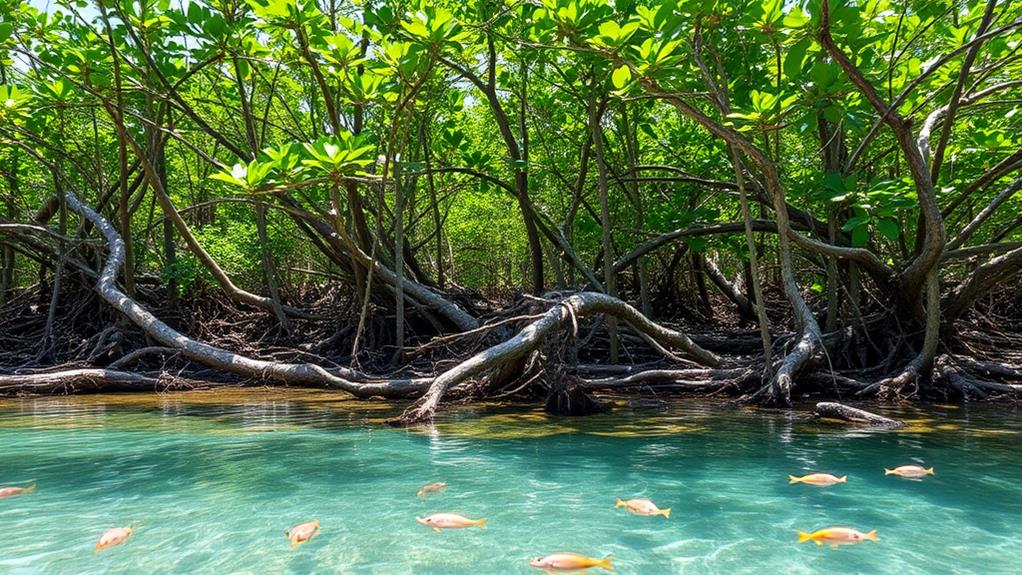
Mangroves are crucial for maintaining biodiversity and ecosystem health, with over 1,500 species calling these unique ecosystems home. Approximately 15% of these species are classified as threatened, highlighting the importance of preserving mangrove habitats.
Mangroves serve as critical nurseries for juvenile fish and crustaceans, with around 75% of commercially caught fish relying on these areas at some stage of their life cycle. For example, species like shrimp, snapper, and grouper depend on mangroves for food and shelter during their early development.
Mangroves also support diverse terrestrial fauna, including endangered species like olive Ridley turtles and various bird species that thrive on the insects found within these ecosystems. The intricate root systems of mangroves create rich and complex habitats that not only promote species diversity but also enhance ecosystem resilience against environmental changes.
Restoration efforts in mangrove ecosystems can significantly boost biodiversity. In fact, studies indicate that such initiatives can potentially add 60 trillion young fish and invertebrates to coastal ecosystems annually.
Nutrient Cycling in Mangroves
Mangrove Ecosystems: Nutrient Cycling Hubs
Mangrove ecosystems are crucial for nutrient cycling, supporting a diverse array of marine life. As mangrove leaves decay, they enrich the surrounding waters, creating a nutrient-rich environment essential for the survival of various marine species.
The Nutrient Cycling Process
Decaying mangrove leaves enrich the water and support invertebrates. Tides then circulate these nutrients to adjacent habitats like mudflats and coral reefs, enhancing productivity across coastal ecosystems.
Organic matter produced by mangroves sustains diverse marine species, including over 1,500 species. Bivalves, such as oysters, thrive in these nutrient-rich areas, while juvenile fish and shrimp benefit from essential resources.
The Importance of Nutrient Cycling
Coastal Protection Mechanisms
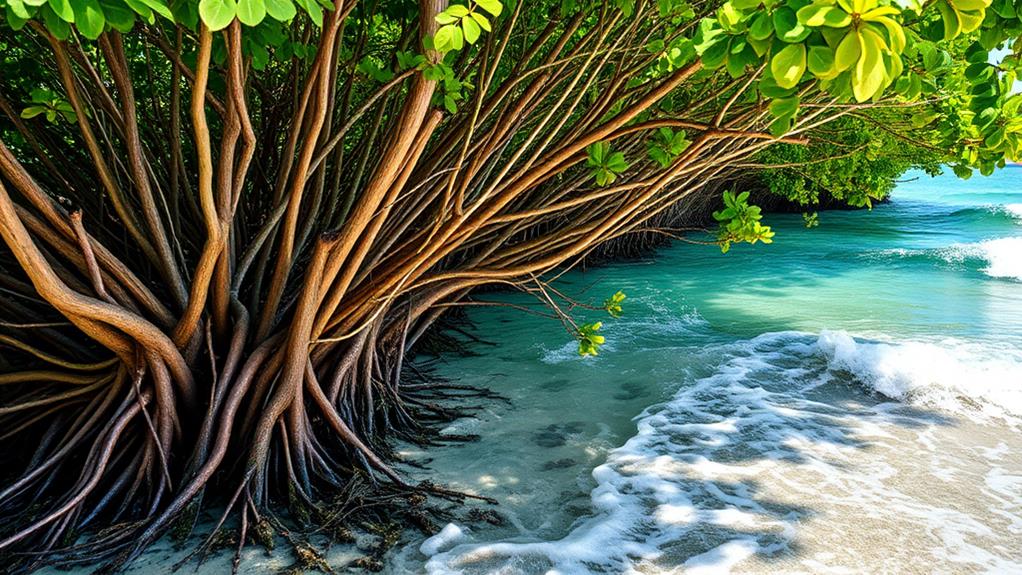
Mangrove Ecosystems as Natural Barriers
Mangrove ecosystems act as natural barriers, stabilizing shorelines and mitigating erosion. Their complex root structures trap sediments, reducing the risks of coastal degradation.
During storms and tsunamis, mangroves can decrease wave heights by 5-35%, providing essential protection to coastal communities against severe weather events.
Buffers Against Wind and Wave Damage
The dense thickets of mangroves serve as buffers against wind and wave damage, significantly enhancing the resilience of coastal ecosystems to climate impacts.
By absorbing the energy of incoming waves, mangroves protect vital infrastructure and human settlements located along coastlines. Their ability to withstand harsh conditions makes them critical players in maintaining coastal stability.
Ecological Balance and Biodiversity
The presence of mangrove ecosystems contributes to overall ecological balance, supporting biodiversity while safeguarding coastlines from environmental threats.
This multifunctional aspect of mangroves emphasizes their importance not just for protection, but also for fostering healthy marine habitats.
Conservation of mangroves is essential for sustainable coastal management and resilience against climate change.
Economic Benefits for Communities
Mangrove ecosystems generate significant economic benefits for local communities. In developing countries, these ecosystems are valued at $33,000 to $57,000 per hectare annually. This substantial value is attributed to the critical role mangroves play in supporting fisheries and shellfish resources, which supply nearly 20% of protein intake for 1.5 billion people globally.
Mangrove restoration can further boost fisheries and livelihoods. The restoration of mangroves could yield an additional 60 trillion young fish and invertebrates each year, providing a significant increase in food resources and income opportunities for coastal residents.
Healthy mangrove ecosystems create opportunities for ecotourism. This not only benefits local economies but also raises awareness of conservation efforts. For example, mangrove-based tourism can generate revenue while promoting sustainable practices and environmental preservation.
By adopting sustainable harvesting practices, local communities can maintain the viability of these crucial resources, securing long-term benefits while protecting their natural environment.
Threats Facing Mangrove Forests
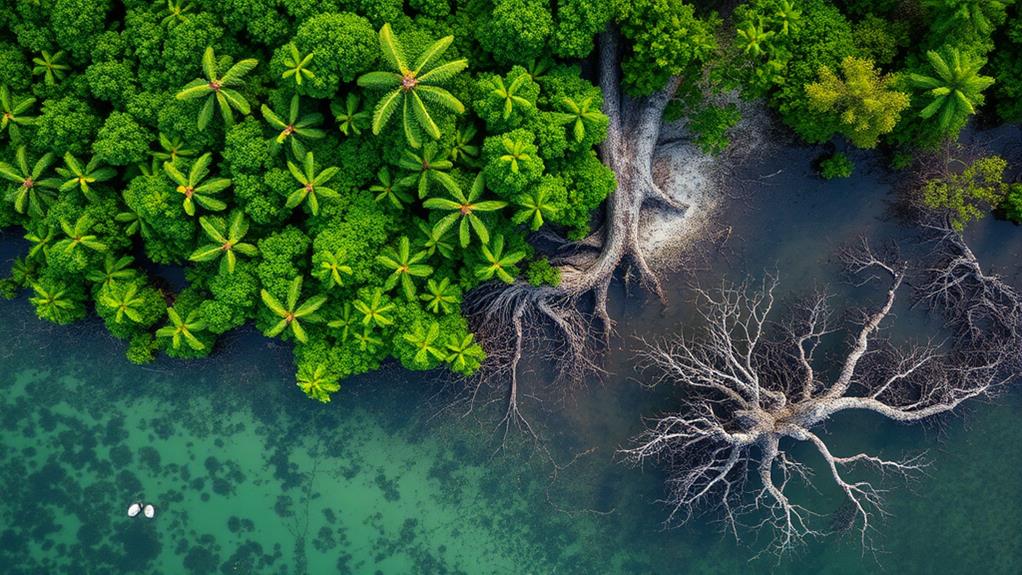
Mangrove Forests Face Significant Threats
Mangrove forests are under severe threat due to human activities, resulting in significant losses over the past 50 years. Approximately 50% of global mangrove forests have been lost, primarily due to urban development and agriculture.
Deforestation is a Major Driver of Mangrove Loss
Deforestation driven by shrimp farming and coastal development has severely impacted mangrove habitats. 38% of mangrove loss is attributed to the expansion of palm oil and rice paddy crops from 2000 to 2012.
For example, the clearing of mangroves for shrimp farming has led to the destruction of habitats and biodiversity.
Pollution and Climate Change Compound the Threats
Pollution from plastics, sewage, and agricultural runoff further degrades mangrove ecosystems, leading to significant habitat loss and a decline in biodiversity.
Rising sea levels and increased salinity due to climate change affect the health and viability of mangroves, making them more vulnerable to other threats.
Conservation Measures are Essential
Immediate conservation measures are necessary to halt further mangrove loss and ensure the sustainability of the remaining habitats.
Conservation Initiatives and Efforts
Conservation initiatives are crucial for protecting the planet's remaining mangrove forests, which are vital for both ecological balance and local economies.
Mangroves support biodiversity and local fisheries by providing healthy coastal ecosystems.
Global collaboration is essential for successful conservation efforts. The Global Mangrove Alliance is a prime example, as it brings together governments, NGOs, and local communities to emphasize the economic and ecological benefits of mangrove ecosystems.
Effective community engagement is critical. Programs that focus on education and participatory management strategies empower local populations to take ownership of conservation efforts, ensuring sustainable practices that enhance mangrove cover.
For instance, local communities can participate in mangrove restoration projects, leading to increased mangrove cover and biodiversity.
Targeted projects yield significant results. Initiatives like WWF's Mangroves for Community and Climate Project aim to restore 2.47 million acres of mangroves in areas that account for 7% of the global mangrove forest.
This restoration can add 60 trillion young fish and invertebrates annually to coastal ecosystems, enhancing biodiversity and supporting local fisheries.
Climate Change Mitigation Potential
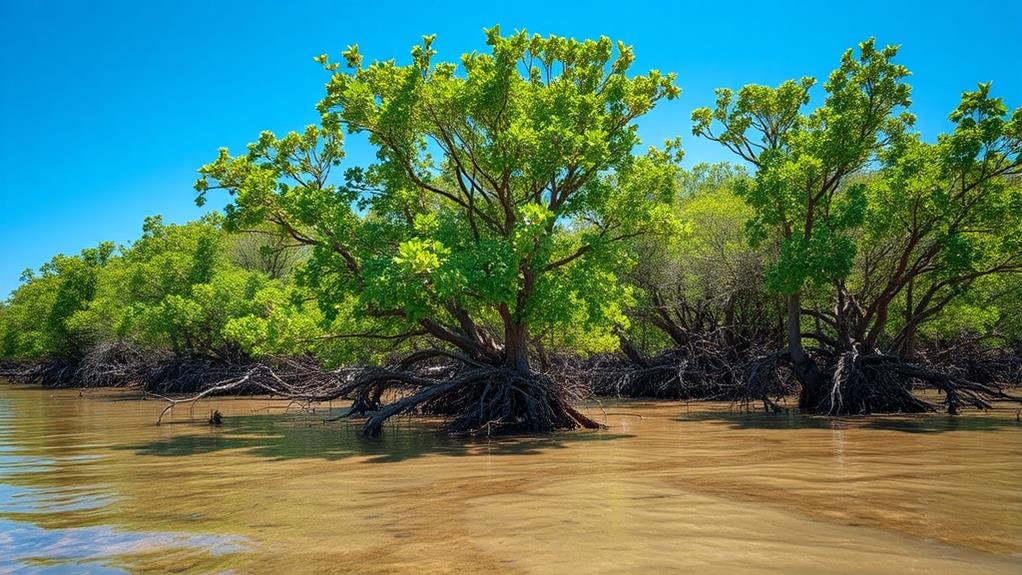
Mangrove Forests: Powerful Carbon Sinks
Mangrove forests are vital carbon sinks, capturing up to five times more carbon than terrestrial forests, storing around 1,000 tonnes of carbon per hectare. This capacity is crucial for effective climate change mitigation.
Coastal Protection and Economic Benefits
Mangroves also protect and restore coastal ecosystems, absorbing wave energy and reducing wave heights by 5-35% during events like tsunamis. This strengthens the resilience of coastal communities against climate impacts. Investing in mangrove restoration is economically viable, with benefits estimated to be four times greater than the costs incurred.
Unique Anaerobic Conditions and Long-term Storage
The anaerobic conditions found in mangrove soils slow decomposition, allowing for long-term carbon storage that can last from decades to millennia. This unique feature enables mangroves to store carbon for extended periods, making them an essential tool in the fight against climate change.
Multiple Benefits of Mangrove Forests
The benefits of mangrove forests can be summarized as follows:
| Benefit | Description |
|---|---|
| Carbon Sequestration | Captures significant amounts of carbon |
| Coastal Protection | Reduces wave impact and enhances resilience |
| Economic Viability | Restorative efforts yield high returns |
| Long-term Storage | Retains carbon for extended periods |
| Emission Reduction | Mitigates urban greenhouse gas emissions |
How to Support Mangrove Conservation
Supporting Mangrove Conservation is Crucial
Maintaining the ecological balance and resilience of coastal areas relies on supporting mangrove conservation. Mangroves provide numerous benefits to communities and marine life, including shoreline stabilization, habitat creation, and disaster risk reduction.
Advocacy is Key
Joining advocacy groups like WWF's Action Center is an effective way to support policies that protect mangrove forests. By engaging with these organizations, your voice can influence legislation essential for mangrove conservation.
This involvement can lead to policy changes that safeguard these vital ecosystems.
Restoration Projects Make a Difference
Participating in local restoration projects focused on replanting mangrove trees is another way to get involved. These efforts not only restore habitats for over 1,500 species but also help reduce disaster risk for coastal communities by stabilizing shorelines.
For example, replanting mangroves in areas affected by hurricanes can help prevent erosion and protect local residents.
Eco-Tourism Supports Conservation
Promoting eco-tourism in coastal regions where mangroves thrive can enhance local economies while fostering an appreciation for these ecosystems.
This, in turn, encourages conservation efforts. By supporting sustainable tourism, you can help create jobs and stimulate local economies, which can lead to a greater investment in mangrove conservation.
Questions and Answers
How Do Mangrove Trees Help Protect Coastlines?
Mangrove trees play a crucial role in protecting coastlines. They do this by reducing coastal erosion and enhancing ecosystem services. For example, their salt tolerance allows them to thrive in harsh environments, creating habitats that support diverse mangrove biodiversity.
Mangrove trees stabilize sediments with their extensive root systems. This helps to mitigate wave impacts and absorb storm energy, reducing the risk of coastal erosion. As a result, they promote habitat restoration, which enhances resilience against climate change.
The protection provided by mangrove trees benefits both the environment and local communities. By maintaining functional coastal areas, they support the well-being of both ecosystems and human populations.
How Do Mangroves Support Marine Life?
Mangroves Provide Crucial Nursery Habitats
Mangroves support marine life by providing crucial nursery habitats that enhance mangrove biodiversity. These habitats are essential for the survival of juvenile fish, crabs, and shrimp, which find shelter and protection among the intricate root systems.
For example, juvenile fish like snappers and groupers hide among the mangrove roots to avoid predators and feed on abundant food sources.
Mangroves Strengthen Local Food Webs
By providing a safe haven for juvenile species, mangroves strengthen local food webs.
This ecological balance promotes species survival and diversity. As these species grow and mature, they contribute to the rich biodiversity of mangrove ecosystems.
Mangroves Mitigate Climate Change Effects
In addition to supporting marine life, mangroves play a vital role in carbon sequestration.
By absorbing and storing carbon dioxide, mangroves help mitigate climate change effects. This ecological function is critical for maintaining the health and resilience of coastal ecosystems.
Supporting Mangroves Contributes to Marine Health
By fostering mangrove habitats, we contribute to the resilience of coastal ecosystems and the overall health of marine environments.
Healthy mangroves are essential for maintaining the delicate balance of marine ecosystems.
How Are Mangroves Used in Coastal Protection?
Mangrove restoration is essential for coastal protection. It enhances coastal resilience, providing effective flood mitigation during storms and high tides. For example, mangroves can reduce wave heights by up to 50%, minimizing the impact of flooding on coastal communities.
Their complex root systems stabilize shorelines, reducing erosion and promoting habitat conservation. This not only protects human settlements but also creates rich environments for various marine species, such as fish, shrimp, and crabs.
Investing in mangrove restoration ensures sustainable coastal ecosystems that can withstand extreme weather events while supporting local economies and livelihoods.
What Mangrove Forests Are and Why They Are Important to Ocean Ecology and Humans?
Mangrove forests are crucial ecosystems that support a rich variety of marine life. They provide habitat for numerous species, such as fish, crustaceans, and mollusks, which rely on the forest's tangled roots and branches for shelter and food.
These ecosystems deliver essential services, including carbon sequestration, which helps mitigate climate change. For example, mangroves absorb carbon dioxide from the atmosphere, reducing greenhouse gas emissions and slowing global warming.
Mangrove forests also protect shorelines from erosion and flooding. By stabilizing the soil and reducing wave energy, they prevent coastal erosion and damage to coastal communities.
Furthermore, they support human livelihoods by fostering fisheries and eco-tourism. For instance, mangroves provide nurseries for commercial fish species, supporting the fishing industry, and their unique landscape attracts tourists, generating income for local communities.
Understanding the importance of mangrove forests is vital for preserving both marine and human health. As environmental challenges increase, it's essential to recognize the role mangroves play in maintaining ecosystem balance and supporting human well-being.